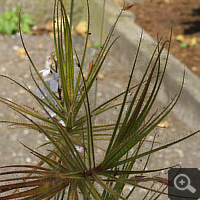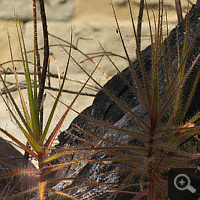Flycatcher Bush (Roridula)
Overview
The protocarnivorous genus includes two species, namely Roridula dentata and Roridula gorgonias, which are endemic in the extreme southwest of Africa. Both species are perennial, more than one metre high, branched shrubs. Both plants produce numerous leaves, which are studded with different pediculated glands. The leaves of Roridula dentata are multi-branched, whereas Roridula gorgonias has unbranched leaves.
Trap mechanism
The principle trap mechanism was already detailed described on the previous site. In contrast to the remaining flypaper traps, the glue drop of the Roridulae does not consist of a polysaccharide (oligosaccharide), but rather bases on rubber and is thereby viscid over decades. Roridulae are indeed highly effective insect catchers, but own enzymes for their utilisation are not produced. For use of the prey the plants draw on an interesting symbiosis with two bug species from the family of the Myridae (capsid bugs). Thereby ‚possesses’ each species its own bug species: On Roridula dentata lives Pameridea marlothii and on Roridula gorgonias the bug Pameridea roridulae. Bugs and Flycatcher Bushes connects a multi-layered symbiosis. The bugs feed on insects, which were caught by the Flycatcher Bush. The prey is broached and sucked. The excretions will later be given directly on the leaves, where they serve as leaf fertiliser. The Flycatcher Bush can because of their thin cell walls a high amount of the excretions resorb. In addition, the larvae of the bugs play an important role in the pollination of the flowers. The bugs profit from Flycatcher Bushes in a triple way. They are fed by them, in the case of danger they find refuge in the leaf axils and the plants are elementally for their oviposition.
The complete mechanism, which prevent an adherence of the bugs on the Flycatcher Bush, are yet not explored conclusively. To this subject exist a number of theories. At first the bugs move with their long legs very carefully on the plant. If they should once stick, then the bug disentangle itself calmly. At this manoeuvre fine hairs on the bug shell should be helpful, which break off simply and act thus as a teflon-coating to a certain extent. Furthermore is posited that the saliva of the bugs contains substances which act as organic solvent.
In addition to two symbiotic bugs species were in the last years furthermore three spider species and a further bug species as residents of the Flycatcher Bush discovered. Nevertheless, these species appear to have a less benefit for Flycatcher Bushes. They are rather to consider as commensals.
Culture and propagation
Until now I have not yet had this genus in culture, so that I can publish at this place no own experiences. Both species are pretty akin in their culture demands. At the natural habitat Roridula gorgonias stands a little bit moister as Roridula dentata. Whereas the first-mentioned species occurs on swampy soils, Roridula dentata apperas on dry sand soils, but reaches with its long tap roots deeper, groundwater-bearing layers of earth. A sandy peat soil (circa 1:1 mixed) is well-suited for both species. For culture great and especially deep pots should be used. In summer Roridulae are desirous of a very light, air-dry location with a very good air circulation. A closed location is thus lethal. Either culture takes place outdoors or in a greenhouse with a very good air circulation. Watered is best from above, keep the soil equal moist. In warm weeks, the plant can also be taken in a slight ebb and flow system. The plants must be wintered cool (circa 10 °C), light and only slight moist.
The propagation of a Flycatcher Bush is something more difficult. On one side, there is the possibilty to propagate them by head cuttings. Thereunto is a few centimetres long sprout tip cut, cleaned from insect corpses and the lowest leaves and stuck vertically into the soil. The pot is given at a half-shaded place and kept equal moist. Do not place the cutting under glass or put over a plastic bag for humidity increase! With some luck, the cutting indicates after some weeks by producing of new leaves the propagation success. Furthermore Flycatcher Bushes are well to popagate by seeds. At the natural habitat germination occurs after bushfires. The over years germinable seed is accordingly as fire germinator to stratify. Thereby Roridula gorgonias should also well germinate partly without any pretreatment. In principle, germination of both species is irregular and can partly take weeks or months. The seeds are light-dependent germinators, so they are to put and press on the permanent moist soil, however without to cover them. Stratification should happen in the following way: On the soil surface some centimetres dried grass are given and burnt. Then the still smoky ash rests are washed in the soil with 60 °C warm water. By these thermal and chemical stimuli, the sprout inhibition of most seeds is to burst.


